A business website is an official online platform that represents a company, providing information, products or services, and acting as a primary channel for customer engagement and credibility.
The types of business websites include e-commerce stores, corporate sites, service provider pages, portfolio websites, and informational blogs.
The benefits of a business website are important as it increases visibility, builds trust, and offers global accessibility 24/7. The Stanford Web Credibility study found that 75% of users judge a business’s credibility by its website design, and Statista reported that e-commerce accounted for 18% of global retail sales in 2024, showcasing its direct impact on reach and revenue.
Examples of successful business websites include Amazon, which uses its site for global e-commerce and personalised shopping; Apple, which maintains a sleek corporate site for product launches and support; and HubSpot, which leverages its platform for inbound marketing and service delivery.
Business website design involves setting clear goals, planning the site structure, creating wireframes, developing content, and a user-friendly, mobile-responsive layout to maximise engagement and accessibility.
The development process includes selecting a domain and hosting, choosing a content management system or custom development approach, integrating analytics and SEO, building front-end and back-end components, and conducting thorough testing before launch.
The cost of developing a business website varies: basic sites range from £1,000 to £5,000, while complex e-commerce or custom solutions exceed 160,000, with ongoing hosting and maintenance costing £29.99 to £100+ per month, depending on the site’s scale and requirements.
What is a Business Website?
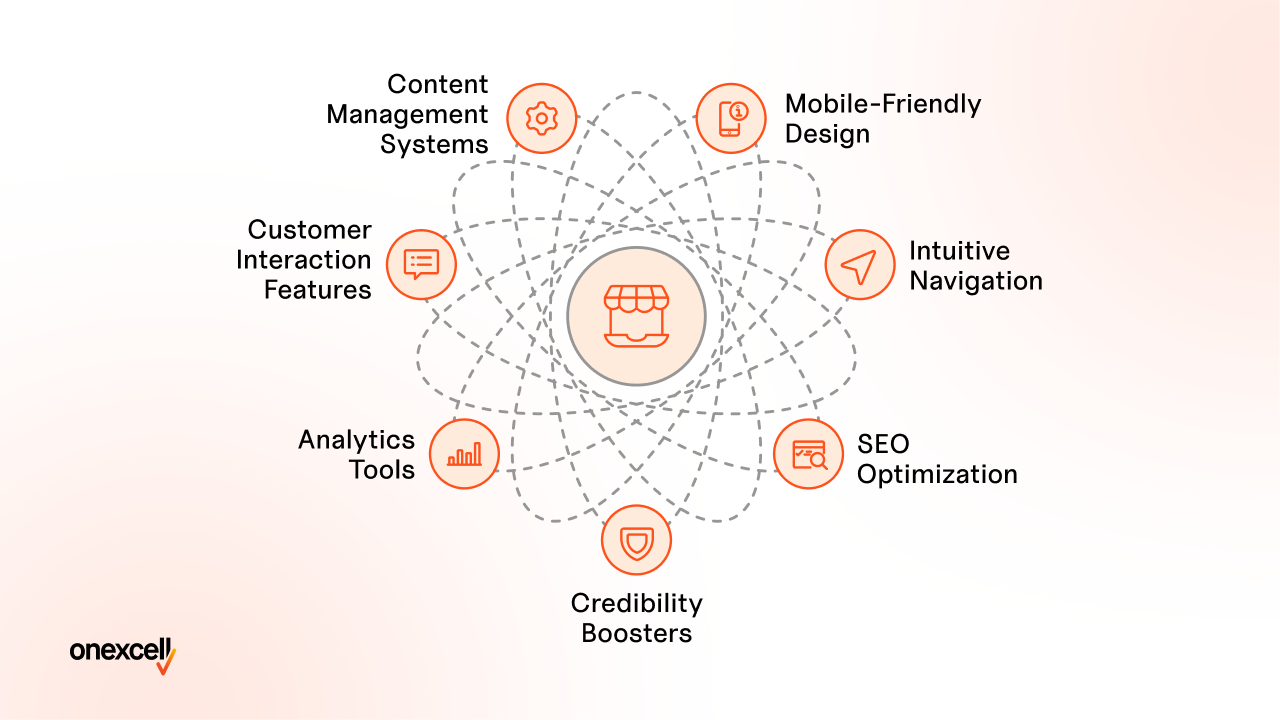
A business website is an online platform developed by a company to present its information, products or services to the public in a professional and accessible format. It serves as a virtual storefront and communication centre, providing details to customers at all times. Unlike static websites, business websites focus on customer interaction, lead generation and conversions through features such as contact forms, live chat and integrated online shopping, while including static elements for foundational content.
Business website features include mobile friendly design, intuitive navigation, SEO optimisation, credibility boosters such as testimonials and certifications, and analytics tools to monitor visitor behaviour and improve site performance.
According to Forbes Advisor’s 2024 report, 71 percent of small businesses have a website, and 81 percent of shoppers look up products online before making a purchase, shows the importance of business websites in building trust and driving revenue.
Modern business websites are built using content management systems such as WordPress, which powers 43 percent of all websites, or through custom development approaches that combine static presentation with dynamic functions such as personalised suggestions and real time stock updates that allow companies to respond to customer expectations.
Why is a business website important?
A business website is important because it strengthens credibility, boosts brand recognition and broadens access to new markets that offers an advantage in the digital marketplace.
According to FounderJar’s report titled “45 Latest Website Statistics For 2025” highlights that 28.8 percent of business is conducted online, and 17 percent of small businesses build websites specifically to establish credibility and authority, emphasising how a professional website directly impacts trust and competitiveness in the digital landscape.
Five billion people are using the internet daily, a website acts as the main point of entry for new customers and serves as a key tool for digital marketing that help businesses connect with audiences at all times and grow at twice the rate of those without an online presence. In today’s market, having a professional website is not simply beneficial, it is for business growth and long term success.
What are elements of a business website?
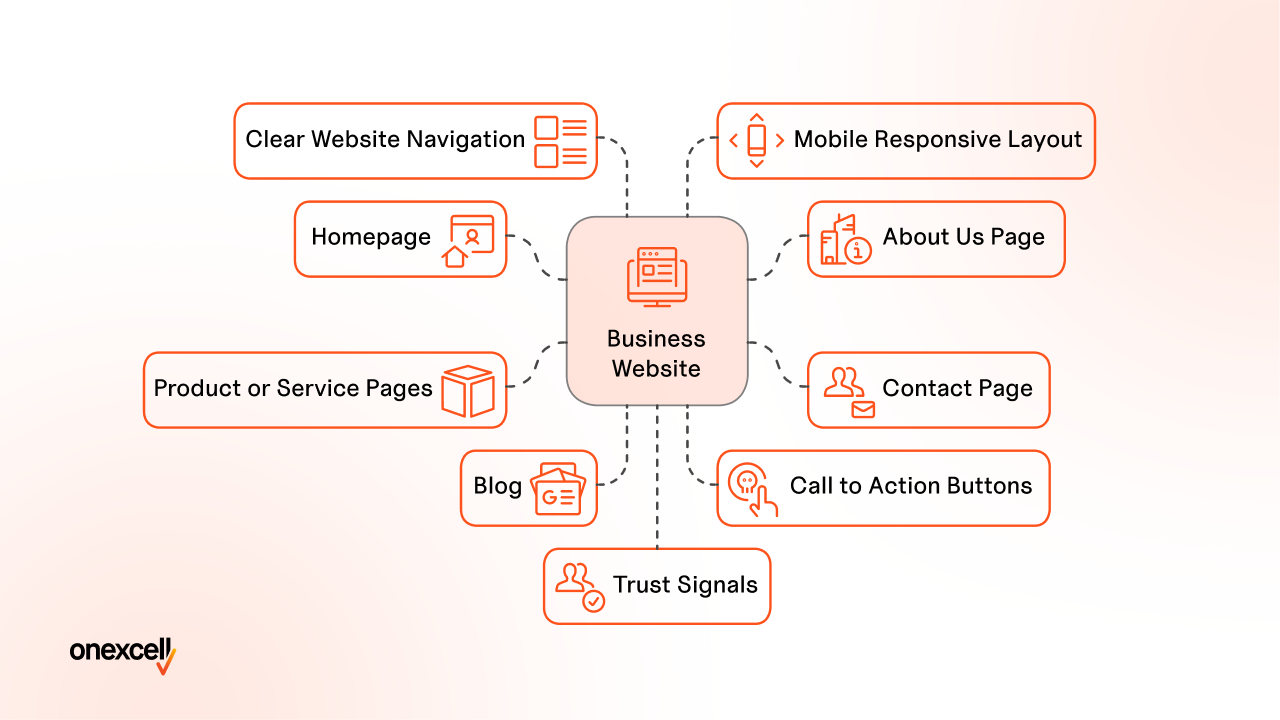
The elements of a business website are listed below.
- Homepage: The homepage acts as the main entry point, offering a clear summary of the business, its purpose and key offerings.
- About Us page: This page provides details about the company’s background, mission, values and team to establish trust and identity.
- Contact page: The contact section includes forms, phone numbers, email addresses and physical location to facilitate communication.
- Product or Service pages: These pages describe each product or service clearly, outlining features, pricing and benefits to inform potential customers.
- Blog: A blog shares articles, news or insights relevant to the industry, supporting SEO efforts and customer engagement.
- Call to action buttons: These guide users to take specific steps such as signing up, booking a service or making a purchase.
- Clear website navigation: Logical menus and internal links help users move through the site easily and find key information.
- Mobile responsive layout: Mobile responsiveness shows that the business site displays and functions well on all screen sizes, improving user experience.
- Trust signals: Testimonials, client logos, reviews and certifications provide social proof and build credibility.
- SEO optimised content: Well-structured, keyword-focused content increases search visibility and attracts organic traffic.
What are Types of a Business Website?
Main types of business websites are designed to meet specific organisational goals, from driving sales to building brand authority, by leveraging structures, content, and functionalities. These categories enable businesses to establish a targeted digital presence, enhance customer engagement, and achieve measurable outcomes like lead generation or online transactions.
The main types of business websites are listed below.
1. E-commerce Websites
2. Corporate Websites
3. Portfolio Websites
4. Blog Websites
5. Service-based Websites
E-commerce Websites
E-commerce websites enable online sales through product catalogues, secure payment gateways, and shopping carts. Keen Home example of e-commerce websites uses Shopify to streamline product browsing and checkout, enhancing customer experience and conversion rates. These platforms integrate inventory management, customer reviews, and personalised recommendations to create a shopping journey.
Corporate Websites
Corporate websites showcase a company’s mission, services, and team to build trust and attract clients. BrandVillage example of corporate websites combines responsive design and client case studies to its branding expertise. These sites include investor relations sections, press releases, and detailed service descriptions to establish transparency and professionalism.
Portfolio Websites
Portfolio websites display work samples and achievements to attract clients or employers. Venkataramanan Associates example of portfolio websites uses high-resolution visuals and project descriptions to demonstrate architectural expertise. Such sites emphasise visual storytelling, project timelines, and client testimonials to showcase credibility and creativity.
Blog Websites
Blog websites publish niche-specific content to engage audiences and improve SEO rankings. The Friday Habit Podcast example of blog websites uses minimalistic layouts to prioritise readability. These platforms feature categories, search functions, and comment sections to foster community interaction and content discoverability.
Service-based Websites
Service-based websites that offer consulting or repairs through testimonials and booking tools. Helideck Certification Agency examples of service-based websites use real project photos and certification details to establish trust. These sites focus on clear service descriptions, pricing models, and contact forms to simplify client inquiries and conversions.
Which websites are suitable for eCommerce businesses?
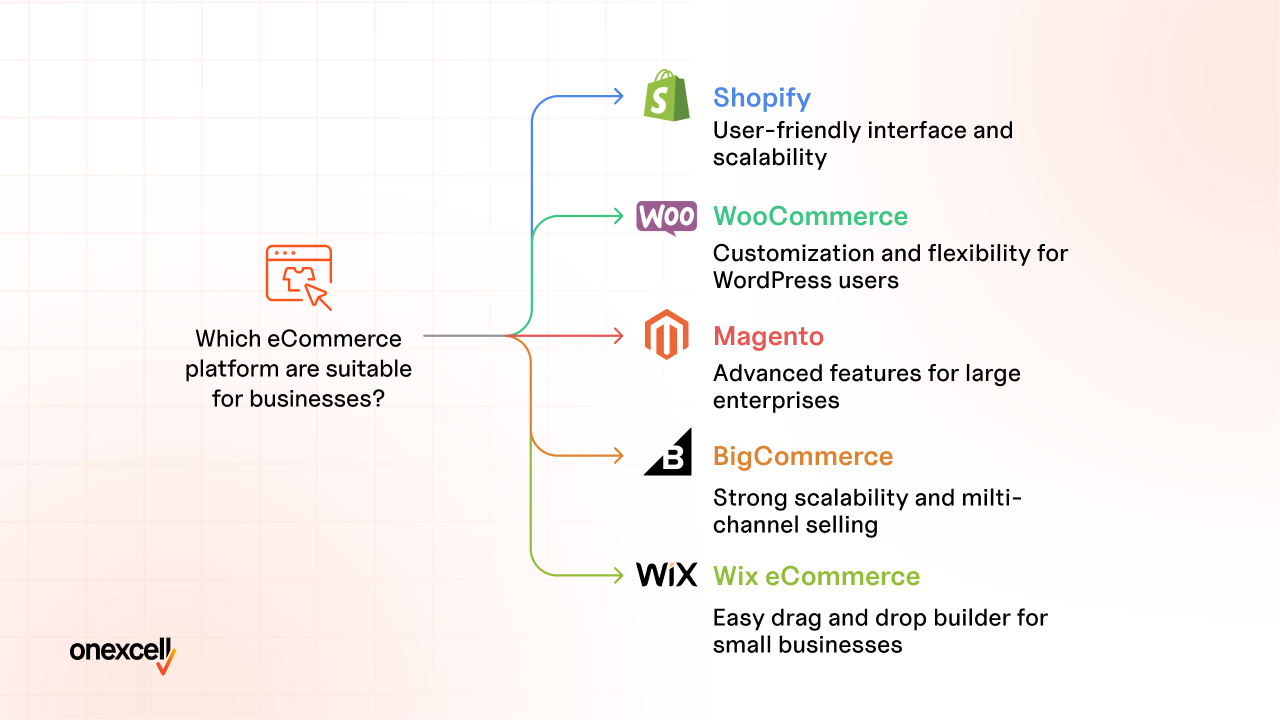
The best websites suitable for eCommerce businesses include:
- Shopify, known for its user-friendly interface, robust app ecosystem, and scalability for businesses of all sizes;
- WooCommerce, a powerful WordPress plugin offering extensive customisation and flexibility for those already using WordPress;
- Magento (Adobe Commerce), favoured by larger enterprises for its advanced features and ability to handle complex, high-volume stores;
- BigCommerce, which provides strong scalability, built-in features, and multi-channel selling capabilities; and
- Wix eCommerce, ideal for small to medium-sized businesses seeking an easy drag-and-drop builder with integrated eCommerce tools.
How to choose the best type of website for a business?
To choose the best type of website for a business depends on a careful assessment of the company’s goals, target audience, and digital strategy.
Start by identifying your business model, whether it involves product sales, services, or content. Next, analyse your customers’ needs and online behaviour to determine which features are such as eCommerce, booking systems, portfolios, or blogs.
Consider factors like ease of use, scalability, and the ability to integrate with marketing tools. Review competitor websites to understand industry standards, that the chosen platform supports mobile responsiveness and SEO optimisation.
According to Simicart’s 2025 report, WooCommerce and Shopify are the most popular eCommerce platforms, holding 3.97% and 2.68% market share among the top one million sites, demonstrating the importance of selecting a proven solution that fits your niche. Lastly, take your budget and technical resources into account to select a website type that aligns with your long-term growth and digital marketing goals.
What is the difference between a transactional and informational website?
The differences between transactional and informational websites are
| Aspect | Transactional Website | Informational Website |
| Purpose | Transactional enables users to complete online transactions such as purchasing products, booking services, or subscriptions. It focuses on converting visitors into customers. | Informational website provides information, educates, or supports visitors by sharing content about products, services, or topics without direct sales functionality. |
| Key Features | Transactional features include Shopping carts, payment gateways, user accounts, order tracking, secure checkout, and customer support integration. | Informational website features include articles, FAQs, blogs, resource libraries, contact forms, and multimedia content designed to inform and engage users. |
| Examples | Transactional website examples are Amazon, Walmart, airline booking sites, subscription services, and online marketplaces like Etsy. | Informational website examples are wikipedia, company brochure sites, educational blogs, news portals, and nonprofit informational sites. |
What are the Benefits of Having a Business Website?
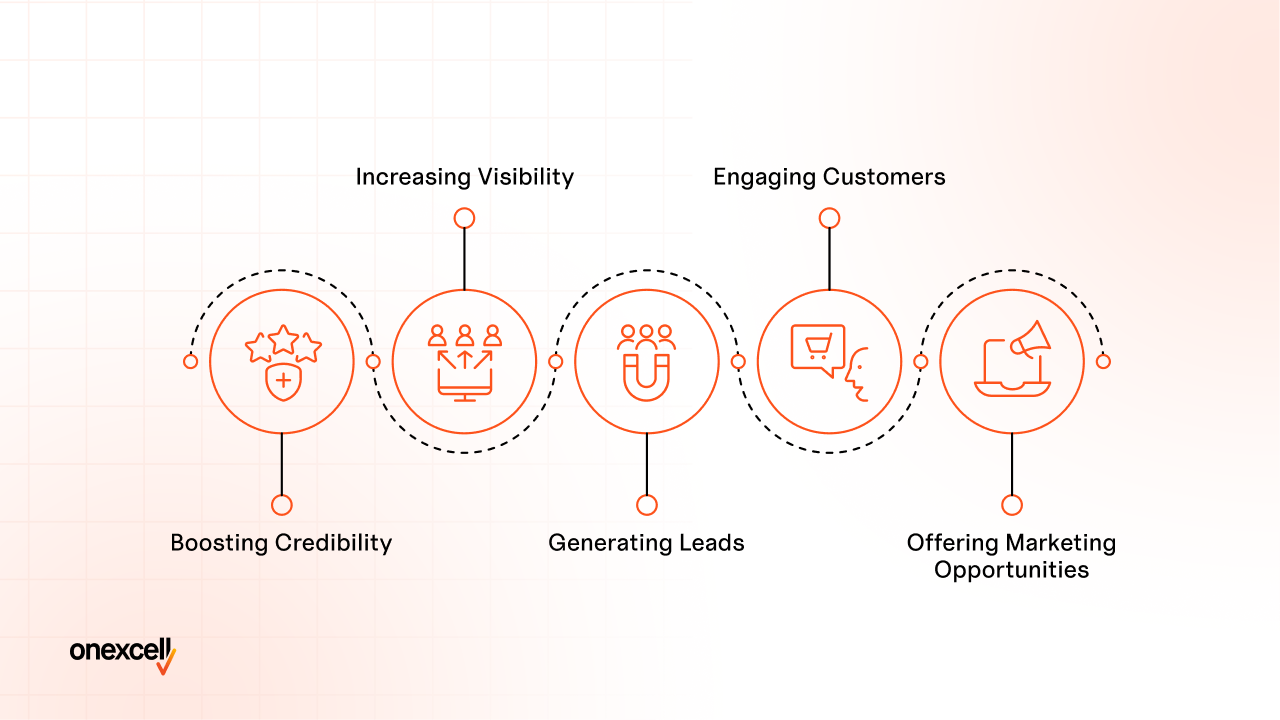
A business website offers numerous benefits, including establishing credibility, expanding reach, and supporting growth by acting as a 24/7 digital storefront and communication hub.
The main benefits of having a business website are outlined below.
- Boosting credibility
- Engaging customers
- Generating leads
- Increasing visibility
- Offering marketing opportunities
Boosting credibility
A professionally designed website instantly enhances your business’s credibility and trustworthiness, signalling to potential customers that you are a legitimate and established player in your industry. Most consumers expect reputable businesses to have an online presence, and a well-structured site with testimonials, reviews, and clear contact information reassures visitors that your business is reliable and values transparency. This first impression is crucial, as many people research businesses online before making purchasing decisions.
Engaging customers
Websites offer interactive features such as live chat, contact forms, booking calendars, and multimedia content, allowing businesses to communicate directly with visitors and provide instant support or information. These elements keep customers engaged, help answer their questions quickly, and create a more personalised browsing experience. A website hosts blogs, FAQs, and resource centres, further encouraging users to spend more time exploring your offerings and building a stronger connection with your brand.
Generating leads
A business website acts as a powerful lead-generation tool by capturing visitor information through forms, newsletter sign-ups, and gated content. Calls to action, such as free consultations or downloadable resources, encourage users to share their contact details, enabling you to nurture leads and convert them into customers. Integrated analytics allow you to track user behaviour and optimise your lead generation strategies for better results over time.
Increasing visibility
Your website makes your business accessible to a global audience around the clock, breaking the limitations of physical location and operating hours. By leveraging search engine optimisation (SEO) and appearing in search results, your website attracts new customers who are actively searching for your products or services. This increased visibility not only drives more traffic but also opens opportunities to reach new markets and demographics, supporting long-term business growth.
Offering marketing opportunities
A website serves as the central hub for all your digital marketing efforts, from content marketing and SEO to email campaigns and social media integration. You promote products, announce special offers, and track the effectiveness of campaigns using built-in analytics tools. This data-driven approach allows for precise targeting, better ROI measurement, and the flexibility to adapt marketing strategies quickly, giving your business an edge in a competitive digital landscape.
Do business websites increase visibility and customer trust?
Yes, business websites help increase visibility and customer trust by improving search engine rankings, presenting a professional online presence, and serving as a trusted source of information for potential customers. A well-designed website optimised for SEO increases the likelihood of appearing in top search results, making it easier for new customers to discover the business online. This enhanced visibility not only drives more organic traffic but also reinforces brand awareness and recall, as studies show it takes five to seven impressions for people to remember a brand.
According to Digital Silk’s “45 Website Statistics To Know In 2025,” published on December 24, 2024, 93% of all internet experiences start with a search engine, shows how a business website increases visibility by improving search rankings and making it easier for customers to discover brands online.
Features such as clear branding, easy navigation, secure browsing, and customer testimonials further foster trust, while consistent and accurate information across the website reassures visitors and encourages them to engage or make a purchase. In today’s digital landscape, a business website is not just a marketing tool—it is central to building a trustworthy reputation and sustaining long-term customer relationships.
What role does a business website play in global accessibility?
A business website provides global accessibility by removing geographical barriers and enabling customers to access products, services, and information from anywhere in the world, at any time. This 24/7 availability allows businesses to reach international audiences and serve customers across different time zones without the limitations of physical location or business hours.
According to FounderJar’s “45 Latest Website Statistics For 2025,” there are about 1.13 billion websites globally, with 252,000 new sites created every day, illustrating the massive scale and reach of online business.
A website’s multilingual capabilities, mobile responsiveness, and integration with international payment systems make it easier for businesses to diverse markets and build a worldwide customer base. By providing continuous access and breaking down traditional barriers, a business website for achieving international reach and maximising online accessibility in today’s interconnected economy.
What are Examples of Successful Business Websites?
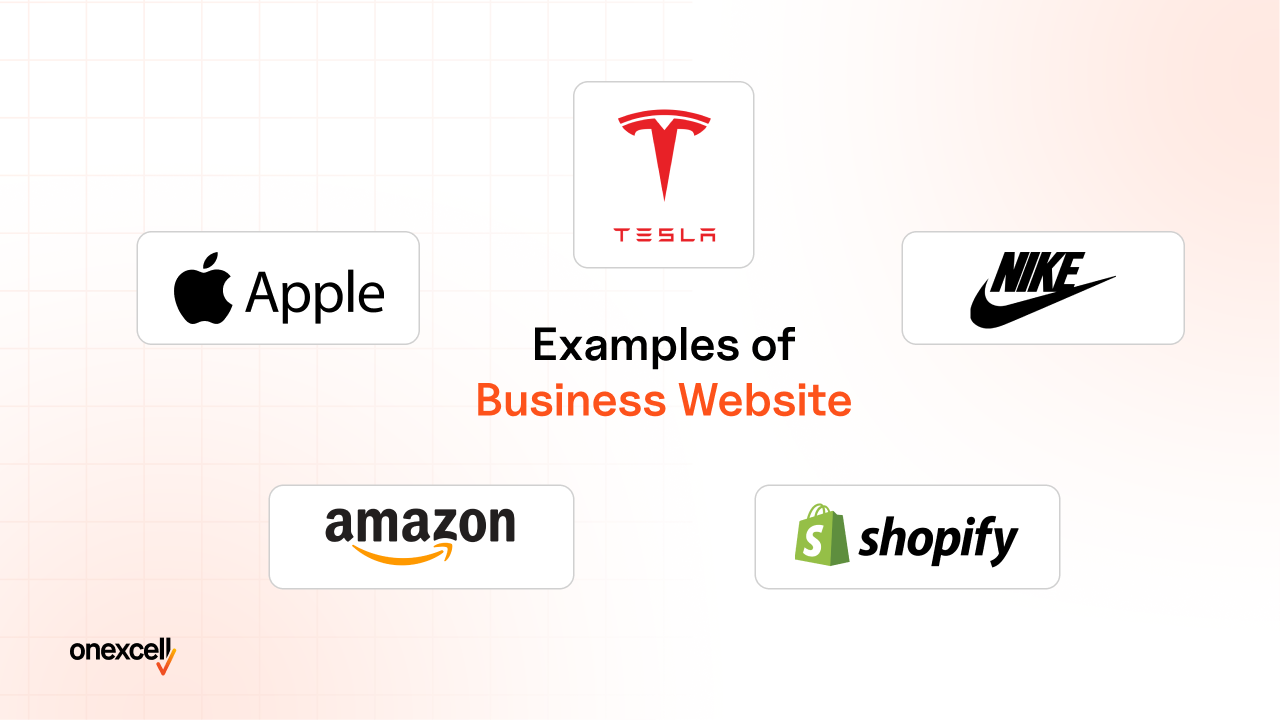
Some successful business websites include Amazon, Apple, Nike, Tesla, and Shopify. These websites are recognised for their exceptional design, user experience, and business performance, setting industry standards for digital excellence and innovation.
The examples of successful business websites are listed below.
- Amazon
- Apple
- Nike
- Tesla
- Shopify
Amazon
Amazon is a global e-commerce leader known for its intuitive navigation, personalised product recommendations, and robust search functionality. The site’s dynamic interface, real-time inventory updates, and one-click purchasing make it a benchmark for online retail success. Its homepage features deals and integration with services like Prime, driving high customer retention and sales conversion rates.
Apple
Apple’s website exemplifies minimalist design, high-quality visuals, and a focus on product storytelling. The site uses interactive product displays, immersive animations, and clear calls to action to new releases and drive pre-orders. Its consistent branding, easy navigation, and accessibility features contribute to a premium user experience and reinforce Apple’s reputation for innovation and quality.
Nike
Nike’s website combines bold visuals, interactive elements, and personalised shopping experiences. The site features product customisation tools, engaging storytelling through campaigns, and transitions between content and commerce. Its mobile-first design, integrated social proof, and localised experiences help Nike connect with global audiences and maintain its status as a leading sportswear brand.
Tesla
Tesla’s website stands out for its sleek, modern design and focus on user-driven exploration. Visitors configure vehicles, schedule test drives, and access detailed product information with ease. The site’s use of high-resolution imagery, interactive car models, and transparent pricing fosters trust and excitement around Tesla’s innovative products.
Shopify
Shopify’s website showcases its platform’s capabilities with a clean layout, clear messaging, and actionable resources for entrepreneurs. The site offers instant access to free trials, customer success stories, and educational content, making it easy for businesses to get started with e-commerce. Its intuitive navigation and integration with support channels enhance the overall user journey and position Shopify as a top choice for online business solutions.
How are business websites designed?
Business websites are designed through a structured, multi-phase process that begins with understanding the company’s goals, audience, and competitive landscape, followed by detailed planning and wireframing to map out the website’s structure and user flow.
Web design services include focus on user interface (UI) and user experience (UX) development, selecting brand-appropriate colours, typography, and visual elements to create an appealing and intuitive layout. Content is developed and integrated alongside interactive features that the site is both informative and engaging. The development phase brings the design to life with coding and functionality, followed by rigorous testing for usability, performance, and mobile responsiveness.
The website is launched and monitored, with ongoing updates and optimisations to align with evolving business needs and user feedback. This approach of the final website is visually attractive, easy to navigate, and strategically aligned with business objectives, with 88% of online shoppers abandoning websites after a poor user experience.
Can consistent branding improve a website’s professionalism?
Yes, consistent branding improves a website’s professionalism and credibility by creating a cohesive visual identity and unified message across all pages. Using a well-defined colour palette, consistent typography, and uniform imagery reinforces brand recognition and helps visitors quickly associate the website with the company’s values and personality. Clear, consistent messaging and tone further establish trust and authority, making the business appear more reliable and established.
According to WPBeginner, 50% of consumers believe that website design is crucial to a business’s overall brand, and Digital Silk’s 2025 statistics show that users are more likely to trust and engage with brands that present a unified and professional appearance. This visual consistency not only boosts first impressions but also increases the likelihood of repeat visits and customer loyalty.
Should website design evolve with business goals?
Yes, website design should evolve with business goals so the site remains effective, relevant, and aligned with the organisation’s strategic direction. Regular updates and redesigns allow businesses to incorporate new features, reflect changes in branding, and respond to shifts in customer expectations or market trends. This adaptability is for supporting business growth, launching new products, and maintaining a competitive edge in a rapidly evolving digital landscape. Scientific data supports this approach: 88% of online shoppers abandon websites after a poor user experience, and businesses that regularly update their websites see higher engagement and conversion rates. By continuously refining the website’s design and functionality, companies better serve their audiences, achieve their objectives, and maximise the return on their digital investment.
What are the Steps Involved in Developing a Business Website?
Common steps in developing a business website follow a strategic, phased approach to the final product that meets business goals, user needs, and technical standards.
The key steps in developing a business website are listed below.
1. Define goals and audience
2. Choose a domain and hosting
3. Design wireframes and layouts
4. Develop and test functionality
5. Optimize for SEO and performance
6. Launch and maintain updates
1. Define goals and audience
This initial step involves clarifying the website’s purpose whether it is to generate leads, sell products, or build brand awareness and identify the target audience’s demographics, preferences, and online behaviours. Defining clear, measurable goals and understanding users’ needs guides the entire development process and helps prioritise features and content.
2. Choose a domain and hosting
Selecting a domain name that is memorable, brand-relevant, and easy to type, as it forms the website’s address on the internet. Choosing a reliable hosting provider to your website is fast, secure, and accessible at all times. Hosting decisions depend on expected traffic, scalability, and technical requirements, influencing site performance and uptime.
3. Design wireframes and layouts
Wireframing maps out the website’s structure and user flow by visually representing page layouts and key elements without design distractions such as colours or images. This stage focuses on user experience and navigation that the site is intuitive and easy to use. Once wireframes are approved, designers develop detailed layouts incorporating branding, typography, and visual hierarchy to create an engaging user interface.
4. Develop and test functionality
Web development begins with coding the front-end (visual elements and interactivity) and back-end (server, databases, APIs) components. Features such as contact forms, e-commerce capabilities, and user authentication are integrated. Rigorous testing follows, covering functionality, responsiveness across devices, load speed, and security for reliable user experience.
5. Optimise for SEO and performance
Search engine optimisation best practices are implemented by optimising page titles, meta descriptions, URL structures, and content keywords to improve search engine rankings. Performance optimisation includes compressing images, minifying code, and enabling caching to reduce load times. These efforts increase website visibility and enhance user satisfaction.
6. Launch and maintain updates
After thorough testing, the website is deployed to the live server. Post-launch, continuous monitoring via analytics tools tracks user behaviour and site performance. Regular updates, including content refreshes, security patches, and feature enhancements, keep the website relevant, secure, and aligned with evolving business objectives.
What are the Costs of Developing a Business Website?
The cost of developing a business website ranges from £1,000 to £3,000, depending on its complexity, features, and whether it’s built using DIY tools or by professional developers. For small businesses creating a basic informational website with a DIY builder, the cost can be as low as £0 to £400 per month, or a one-time setup fee of up to £360.
In contrast, employing professionals or web design agencies to create a custom website ranges from £800 to £75,000, with more complex e-commerce or enterprise-level sites potentially reaching £120,000 or more. Template-based websites cost under £800, while basic custom websites tend to fall between £2,000 and £5,000. Advanced sites requiring sophisticated features such as customer portals, booking systems, or integrations with third-party platforms may cost between £5,000 and £20,000. Large-scale projects with multiple systems, high-end design, and custom functionalities exceed £20,000 – £40,000+.
Ongoing expenses that includes hosting, site maintenance, security, and regular content updates that should also be factored into the total cost. While professional development represents a higher initial investment, it offers better search engine optimisation, higher conversion rates, and increased brand credibility. These advantages lead to a positive return on investment within three to six months.
On the other hand, DIY solutions may save upfront costs but demand time commitment and result in missed opportunities due to limited features and a weaker user experience. Ultimately, budgeting for a business website involves aligning your available resources with your objectives, desired capabilities, and plans for long-term growth, to select the most effective and scalable option.
What factors contribute to website design and development costs?
The main factors influencing website costs include several elements that affect both the initial development and the ongoing maintenance of a business website. These key components collectively determine the overall financial investment required for a successful project.
Domain and hosting
Purchasing a domain name costs between £6.99 and £9.99/ per year, while hosting expenses vary depending on the chosen plan. Shared hosting may start from as little as £1.50 to £4 per month, whereas dedicated or cloud hosting for high-traffic websites range from £55 to well over £800 per month. Your hosting choice has a direct impact on site speed, reliability, and scalability, making it a critical budget consideration.
Web design complexity
The complexity of your website’s design plays a major role in overall cost. Basic brochure-style websites with minimal design elements are more economical, while those requiring intricate visuals, animations, and bespoke user interface components will be considerably more expensive, as they demand greater design expertise and development time.
Custom development needs
Functionality such as user logins, dynamic forms, appointment booking systems, or advanced workflow automation adds to development costs. Custom web design involves original layouts, interactive elements, and bespoke user interfaces, offering a distinctive and professional online presence that enhances user experience and reinforces brand credibility.
E-commerce features
Implementing e-commerce capabilities such as shopping baskets, payment integration, inventory systems, and customer accounts raises the cost due to both the technical complexity and the security protocols required. While small online shops are relatively affordable, large-scale platforms with multi-vendor support and detailed analytics are far more costly.
Maintenance and updates
Ongoing website expenses include regular maintenance, content updates, software upgrades, performance tuning, and technical assistance. These continual improvements make your website secure, up to date, and aligned with evolving business objectives. As such, maintenance should be factored into your long-term budgeting plans.
What can businesses learn from websites like Amazon and Etsy?
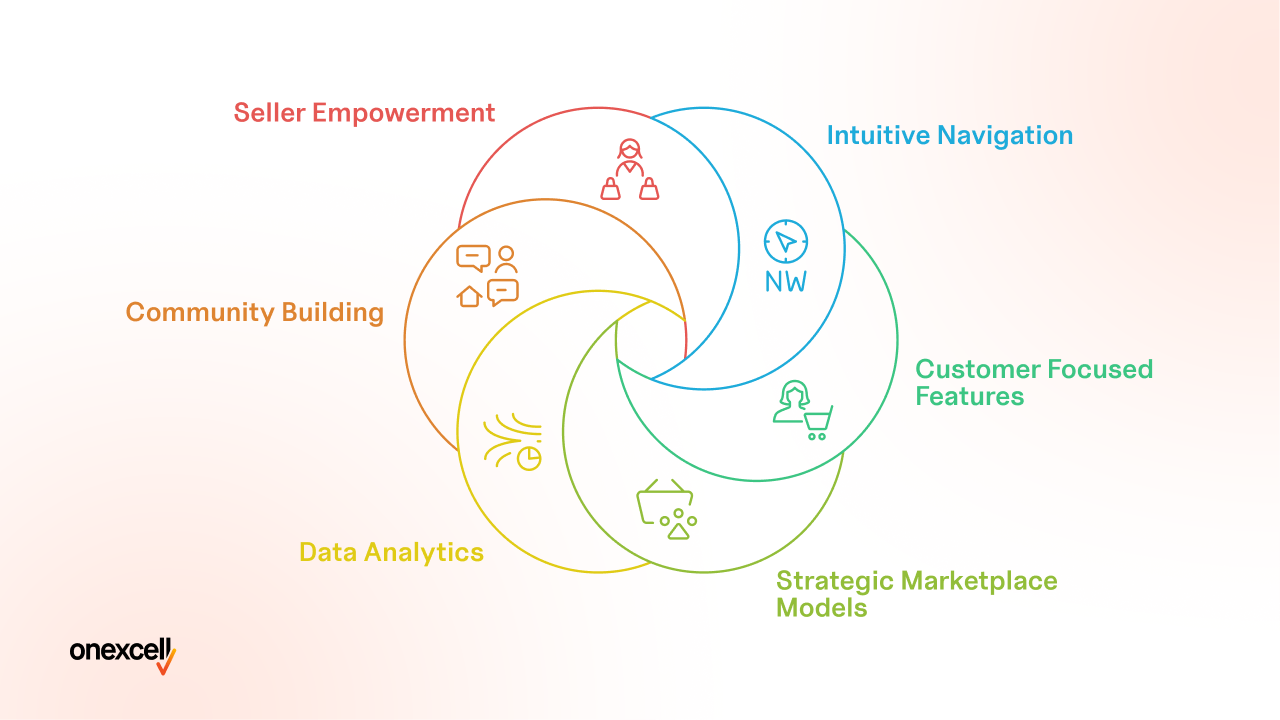
Businesses learn from websites like Amazon and Etsy by prioritising intuitive navigation, customer-focused features, and strategic marketplace models that foster engagement and growth.
Amazon leads with its user-friendly interface, personalised recommendations, and checkout, creating a smooth shopping journey that encourages repeat visits. By using data analytics to understand customer behaviour, refine product listings, and customise marketing efforts, Amazon generates around 35% of its revenue through its recommendation engine alone.
Etsy has built a thriving community of over 8 million sellers and 95.5 million buyers by championing handmade and vintage products, promoting social responsibility, and offering supportive seller tools.
Features such as free global shipping and responsive customer service contribute to its impressive 40.1% retention rate. Both platforms illustrate the power of using data to improve user experience and streamline transactions, while also emphasising the importance of balancing customer satisfaction with seller empowerment. These insights show how businesses enhance their websites by personalising user journeys, improving usability, and building marketplaces that support sustainable, long-term growth.

